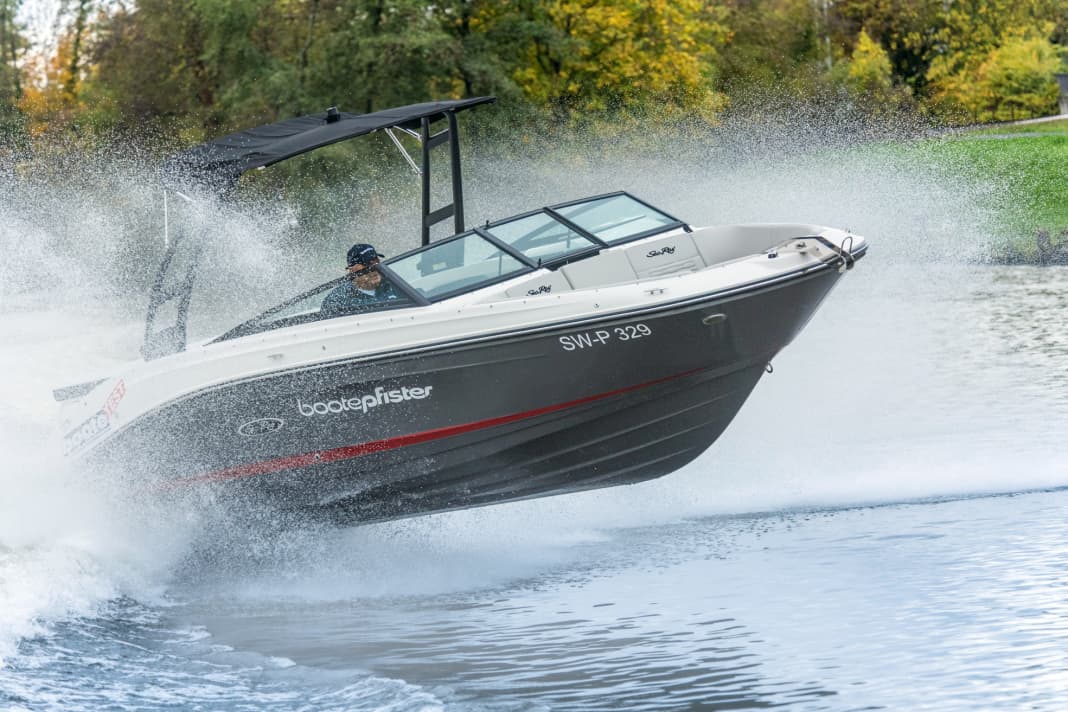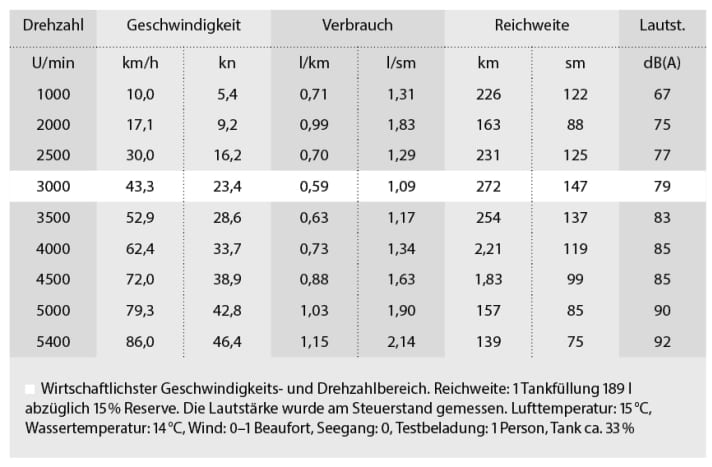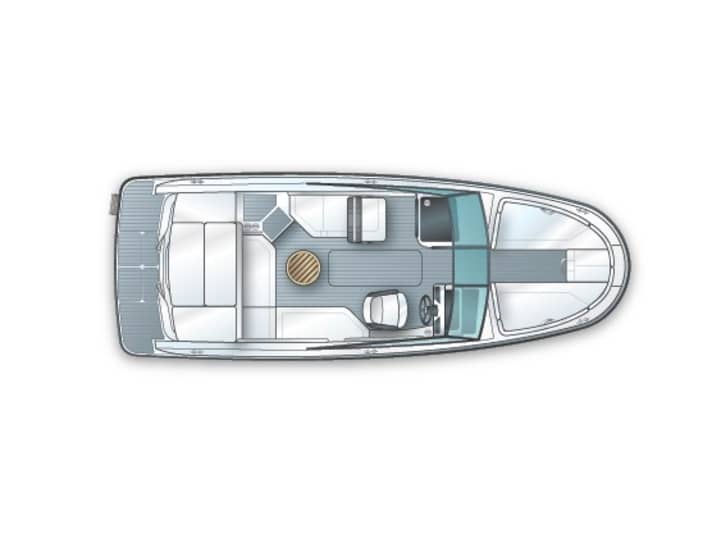




In this article:
Anyone who thinks I've already seen this boat in BOOTE is not mistaken, as we published the outboard model in issue 3/22 and another model with a 250 hp inboard in 10/17. Our current 230-SPXE model is equipped with the latest, largest possible inboard, a 6.2-litre petrol engine with 350 hp. An interesting motorisation: after all, is the more powerful engine any less economical than its weaker counterparts, and what are the benefits of more speed?
First of all, let's take a quick look at the boat: as with the sisters, there is a sunbed and a seating area aft. The cushions are firm and comfortable. The same applies to the seat/lounger unit in the open bow. This is also a great place to sit, lie down and relax. A small but important feature is the toilet compartment in front of the passenger seat. A chemical toilet is fitted here as standard.
Compared to the other two boats, the helm station has modern equipment, with a Vessel View instrument (9" monitor) installed in the centre and no other round instruments. The switches and music system are easily accessible next to the steering wheel. The driver sits in a sporty bucket seat, from where he has everything in view and under control. A slightly tinted windscreen (without windscreen wipers) protects the crew from the wind.
We cast off and do our test laps on the Main. First of all, the low speeds at which the Sea Ray behaves typically like a glider. It yaws a little and weight shifts have a moderate effect on course stability. Then into the acceleration phase to planing speed: The Sea Ray only needs a few seconds for this and is already planing from 2500 rpm and at 3000 rpm (23.4 kn) she makes a good course-stable journey, which is also the most economical speed, with one tank of fuel minus 15% reserve you can travel 147 nm. Looking back at the outboard version: at almost the same speed, it also travelled economically, but required 1.36 l/sm, which is 0.27 l/sm more than our current test version. The 250 inboard version consumes almost the same amount of fuel (1.10 l/sm), but it is also a good 2 kn slower.
Consequently, the more powerful drive in our test boat is not thirstier in economic planing speed - in litres per nautical mile. At full throttle, however, the consumption values are higher. Here, the 350 hp version clearly outperforms the outboard (43.2 kn) and the 250 hp inboard version (39.0 kn) at 46.4 kn.
If you chase the boat over the slalom course at high speed, you have everything well under control, and the same applies when the steering is torn. In tight, fast circles, the power trim should be set to "down" and the carousel ride is really tight. Its performance makes it ideal for towing wakeboards and the like. There is an extra wakeboard package for this (at an additional cost of just under 6000 euros).
Workmanship and installation are of a high standard. The hand bilge pump is missing, but the fire extinguishing system in the engine compartment is standard.
Sea Ray 230 SPXE measurement results

Our test verdict on the Sea Ray 230 SPXE
DRIVING & MANOEUVRING
- + sporty driving characteristics
- + well suited as a towing boat
PROCESSING & TECHNOLOGY
- + good processing quality
- + clean installations
SAFETY
- + Fire extinguishing system in the engine compartment
- - No windscreen wiper and no manual drain pump
COMFORT ON BOARD
- + Comfortable seat/lounger units in the cockpit and open bow
Conclusion
With its V8 engine, the Sea Ray 230 SPXE is really sporty on the move and, compared to its competitors, scores highly in terms of top speed and fuel consumption (l/sm) when cruising. It is ideal as a towing boat for banana, wakeboard and co.
Technical data of the Sea Ray 230 SPXE
The boat
- Shipyard: Sea Ray/USA
- Type: 230 SPXE
- CE category: C/13 persons
- Hull and deck: Plastic
- Length over everything: 7,15 m
- Width: 2,54 m
- Weight: approx. 2050 kg
- Clearance height (with bracket at the top): 2,10 m
- Depth: 0,98 m
- Fuel tank: 189 l
- Freeboard (at hedge entrance): 0,84 m
- Cockpit side height inside (with rear ring): 0,52 m
- Sun lounger: Foredeck 1.80 m x 1.80 m; stern couch 2.12 m x 0.95 m
- Max. motorisation: Interior w. 257 kW (350 hp)
- List price (with test engine): 92.500 €
- Distribution: Boote-Pfister, Wahlweg 6, 97525 Schwebheim, www.bootepfister.de

The motor
- Manufacturer: MerCruiser
- Type: 6.2 L 350 ECT Bravo III
- Performance: 257 kW (350 hp)
- Full load speed: 5000-5400 rpm
- Cylinder: V8
- cubic capacity: 6,2 l
- Alternator: 12 V/70 A
- Fuel: Petrol
- Translation (Bravo III): 2,20 : 1
- Test propeller: Double propeller 24"

